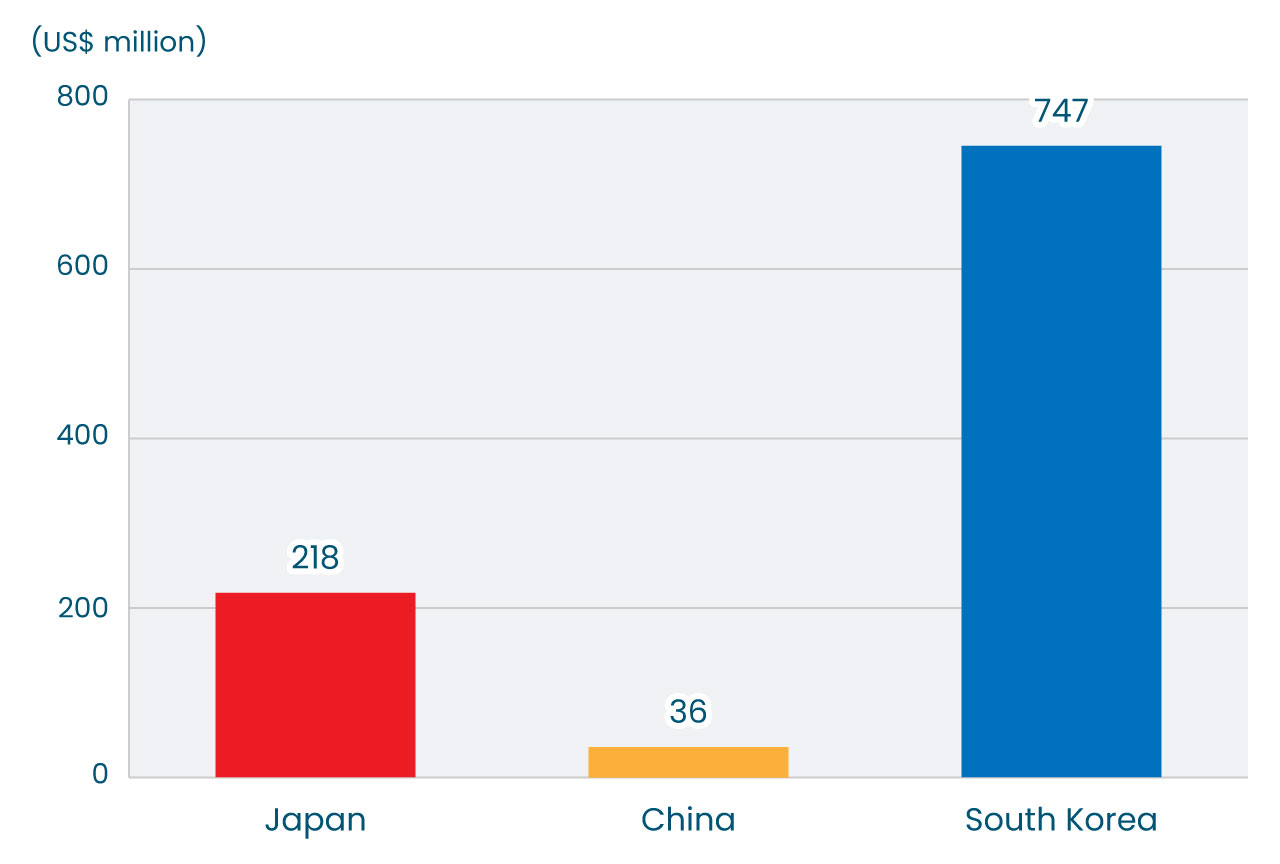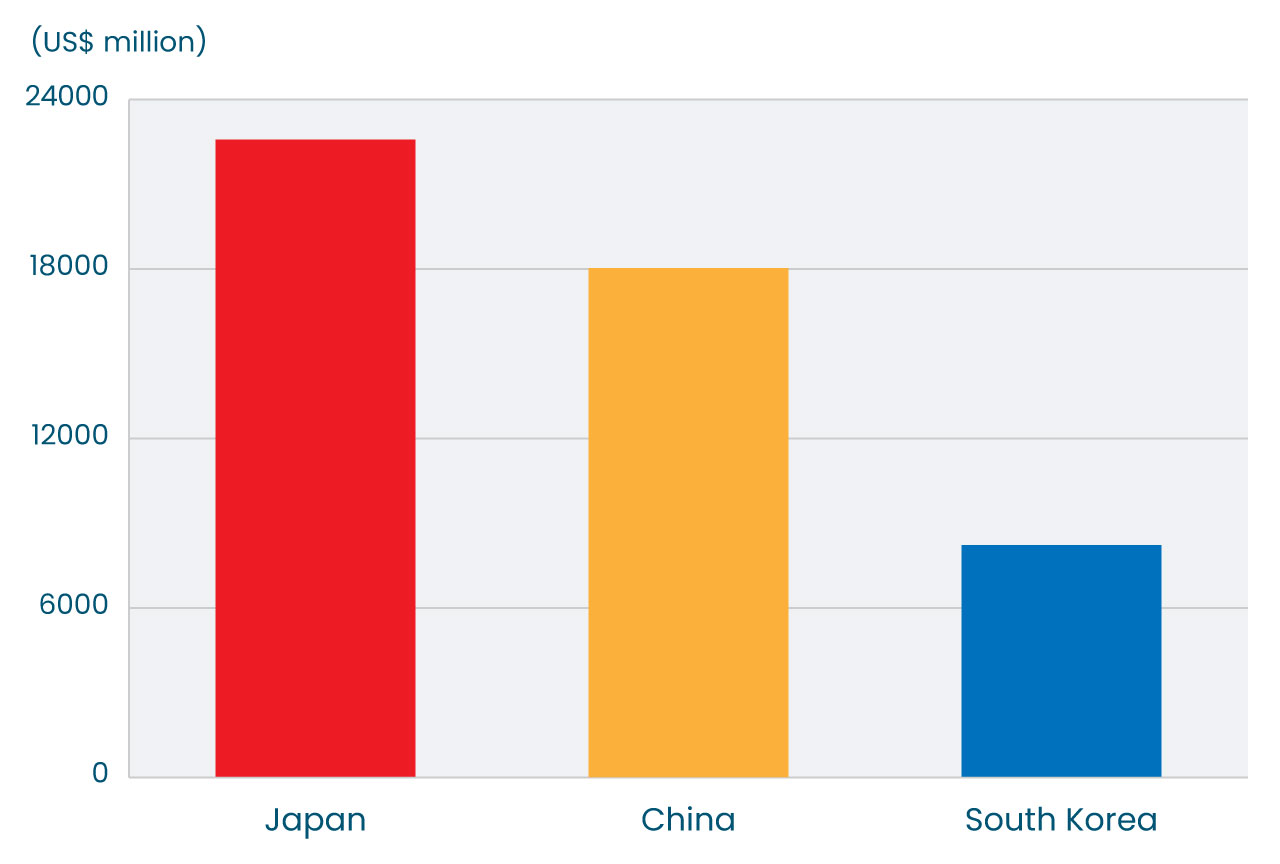AnimeJapan is held every March at Tokyo Big Sight in Koto Ward. It is one of the world’s biggest animation consumer shows and in 2024 was attended by more than 130,000 anime fans and
businesspeople over its March 23-26 duration.
The Japan External Trade Organization (JETRO) took the opportunity to organize online business talks with overseas content buyers. A record 69 buyer companies from 28 countries,
including Thailand, Germany, and France, participated in 220 talks with Japanese content providers. JETRO also exhibits at various similar events, such as the Thailand Game Show in
Thailand and the Animation & More Summit in India, to grow the fan base for Japanese content.
World-class box office results for anime and special effects films
Among Japanese content, anime, home console games, and anime characters are particularly competitive internationally. In 2016, Japanese filmmaker Makoto Shinkai’s Your Name broke box office records for a Japanese animated film in Europe, the United States, and Asia.

The animated film Your Name was an international hit. (© 2016 TOHO/CoMix Wave Films/KADOKAWA/JR KIKAKU/AMUSE/voque ting/Lawson HMV Entertainment.)
The 2023 special effects film Godzilla Minus One, starring the mighty Godzilla (who has even appeared in Hollywood movies!) has made more recent headlines. Godzilla Minus One became the highest-grossing Asian live-action film ever as of January 2024 and, in March 2024, won the Academy Award for Best Visual Effects.
Anime characters are a magic lamp for diverse revenue streams
Japan’s content industry has an edge when it comes to anime characters and other intellectual property. Pokémon, Hello Kitty, Anpanman, and the Mario rank among the world’s top media franchises by all-time revenue. These characters are a magic lamp in generating revenues from their appearance in games as well as animated and live-action films and from merchandise sales. And Japanese content firms are leveraging that advantage to ramp up their offshore market development.
The world’s top media franchises by all-time revenue (up to 2023)
| Name of the franchise (character or media) | All-time revenue | |
|---|---|---|
| 1 | Pokémon | US$147 billion |
| 2 | Hello Kitty | US$89 billion |
| 3 | Winnie the Pooh | US$76 billion |
| 4 | Mickey Mouse & Friends | US$74 billion |
| 5 | Star Wars | US$70 billion |
| 6 | Anpanman | US$56 billion |
| 7 | Disney Princess | US$46 billion |
| 8 | Shonen Jump/Jump Comics | US$40 billion |
| 9 | Mario | US$38 billion |
| 10 | Marvel Cinematic Universe | US$35 billion |
| 11 | Harry Potter | US$32 billion |
| 12 | Transformers | US$30 billion |
| 13 | Spider-Man | US$29 billion |
| 14 | Batman | US$28 billion |
| 15 | Dragon Ball | US$27 billion |
| 16 | Gundam | US$24.7 billion |
Source: METI, based on Visual Capitalist’s “The World’s Top Media Franchises by All-Time Revenue.” The all-time revenue figures are reference values drawn from the websites of the various franchises, etc., and may have been updated subsequently. Note: Names in blue are Japanese content.
Godzilla Minus One is its producer’s first overseas direct distribution
For producer Toho Co., Ltd., Godzilla Minus One-which became a box office hit across the United States-marked its first time handling the overseas distribution of a film when it marketed Godzilla Minus One directly to overseas cinemas and promoters. Toho has traditionally waited for overseas distributors to see a film doing well in Japan and then to buy from it the rights to what would become an overseas sensation. Godzilla Minus One’s distribution represents Toho’s shift to a more aggressive approach to developing the offshore market.

Film producer Kenji Yamada is looking beyond Japan to overseas markets.
Kenji Yamada planned and produced Godzilla Minus One and worked on Monster, which took the Best Screenplay Award at France’s Cannes Film Festival. He knows how to sell Japanese live-action films overseas. Yamada plans to use the connections that he has developed through these films and their recognition at film festivals to hold case method workshops to pass on his know-how. He identifies the following keys to selling Japanese live-action movies abroad:
To break free from the Galapagos-like isolation of the Japanese market, we should do a really deep dive into those overseas movies that have been well-received and that have achieved box office success around the world. What we need is a knowledge hub where we archive as case studies valuable knowledge and experience that is only tacitly understood so that any Japanese creator eyeing world markets can learn from it. When a string of world-class Japanese live-action films start to emerge from that hub, it will open the way for industrialization in the true sense of the word.
The Japanese government, like Toho, has also changed its stance. At a meeting of the Council of New Form of Capitalism Realization held by the cabinet office in April 2024, then-Prime
Minister Fumio Kishida stated that “government-wide efforts” would be made to “formulate a strategy for the revitalization of the contents industry through public-private collaboration.”
The content industry, therefore, has been positioned as a key industry for a new era with proactive government support.
In that respect, South Korea is ahead of Japan. Its government-supported Korea Creative Content Agency (KOCCA) has done much to foster the international popularity of Korean films and
K-pop. KOCCA has developed the overseas market by setting up business centers in eight locations, including the United States, China, Europe, Southeast Asia, and Japan.
Japanese government to provide support through overseas bases
The Japanese government is not standing idly by. The Ministry of Economy, Trade and Industry (METI) is exploring paths for government support of Japan’s content industry.
Any sustained offshore expansion of Japanese content hinges on establishing bases overseas from which to build networks with local industry personnel and fan communities and gather
information. Other vital support includes promoting and matching Japanese content businesses with overseas content buyers.
JETRO is leading the way with its establishment of bases in the United States, India, and Thailand to promote Japanese content. This is in addition to its arrangement of online business
talks regarding live-action films, music, and animated films and shows in conjunction with exhibitions in various countries; its research into local market regulatory requirements; and
its advisory services for Japanese content companies wanting to move into markets abroad.
According to a METI official, JETRO has offices in over 70 countries, and METI’s plan is to take advantage of JETRO’s physical presence in local markets and experience in assisting
Japanese firms from various fields to expand overseas. METI intends to help Japan’s content companies get their products into offshore markets by deploying content specialists to JETRO’s
far-flung offices.
In fiscal year 2024, meanwhile, METI launched the subsidy program JLOX+ (Japan Content Localization and Business Transformation Plus) to foster Japanese content development overseas.
JLOX+ provides translation and overseas promotion of Japanese content. The popularity outside Japan of Your Name and of Studio Ghibli, Inc.’s The Boy and the Heron is in fact partially
due to JLOX+.
The Japanese government is thus channeling its efforts into logistical support for production and marketing and leaving content creation to industry professionals. To avoid bureaucratic
compartmentalization, the government has established the Content Industry Public-Private Council as a “command tower” overseen by the prime minister himself.
Overseas revenue from animated films and shows

Note: China includes live-action films.
Overseas revenue from live-action films and shows

Note: China includes animated films.
Overseas revenue from game consoles and software
 Note: Primarily for home use in Japan and for smartphone and computer use in China and South Korea.
Note: Primarily for home use in Japan and for smartphone and computer use in China and South Korea.Source of three graphs above: Based on the March 2023 Human Media Co., Ltd., Current Status of the Content Industry report commissioned by Keidanren (the Japan Business Federation).
Positioning content as a key Japanese industry
Content is in fact one of Japan’s principal industries and is sure to grow. METI statistics from various surveys show the Japanese content industry garners ¥4.7 trillion in offshore
sales. This is well below the Japanese auto industry’s ¥17 trillion export value, but it is favorably comparable with Japan’s semiconductor industry’s ¥5.7 trillion and steel
industry’s ¥5.1 trillion export values. Predictions, moreover, are for the content market’s continued expansion. PricewaterhouseCoopers forecasts 5% growth per annum globally for
about the next five years.
Animation and film production are also great job creators domestically. International fans continue to pilgrimage to the Kamakura railway crossing made famous by the animated series Slam
Dunk and to the shrine in Shinjuku, Tokyo, that appears in the closing scene of Your Name. This boosts Japan’s tourism industry and its need of employees. Cultivating overseas markets
for Japanese content, therefore, will have a major beneficial ripple effect on Japan’s economy.
Building Japan’s soft power through content will revitalize the Japanese economy and heighten the country’s attractiveness for investors. Smartphones and streaming platforms have granted
worldwide access to Japanese content and boosted sales of related merchandise, such as toys, clothing, and accessories developed as anime collaborations. Partnerships with Japanese
content providers thus represent a great potential business opportunity.
A prime example is provided by the Chinese variety store chain Miniso, which has recently been setting up pop-up stores that feature the Japanese anime character Chiikawa in China’s main
cities. They attract long queues of young people. This exemplifies how the Japanese content industry can capture the attention of international businesses as well as anime and film fans.




